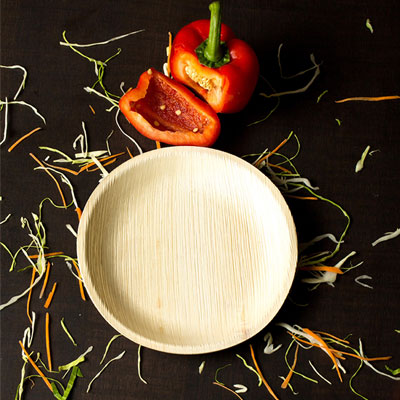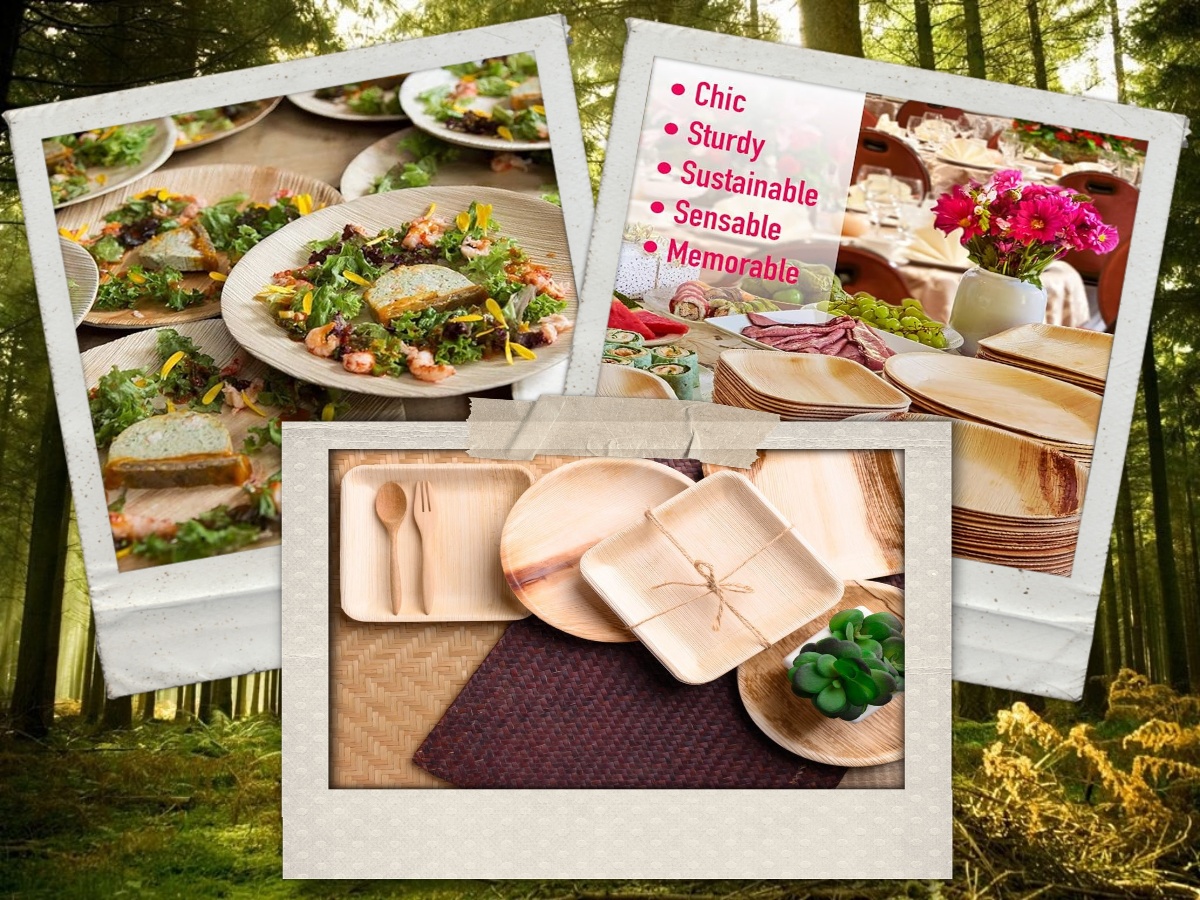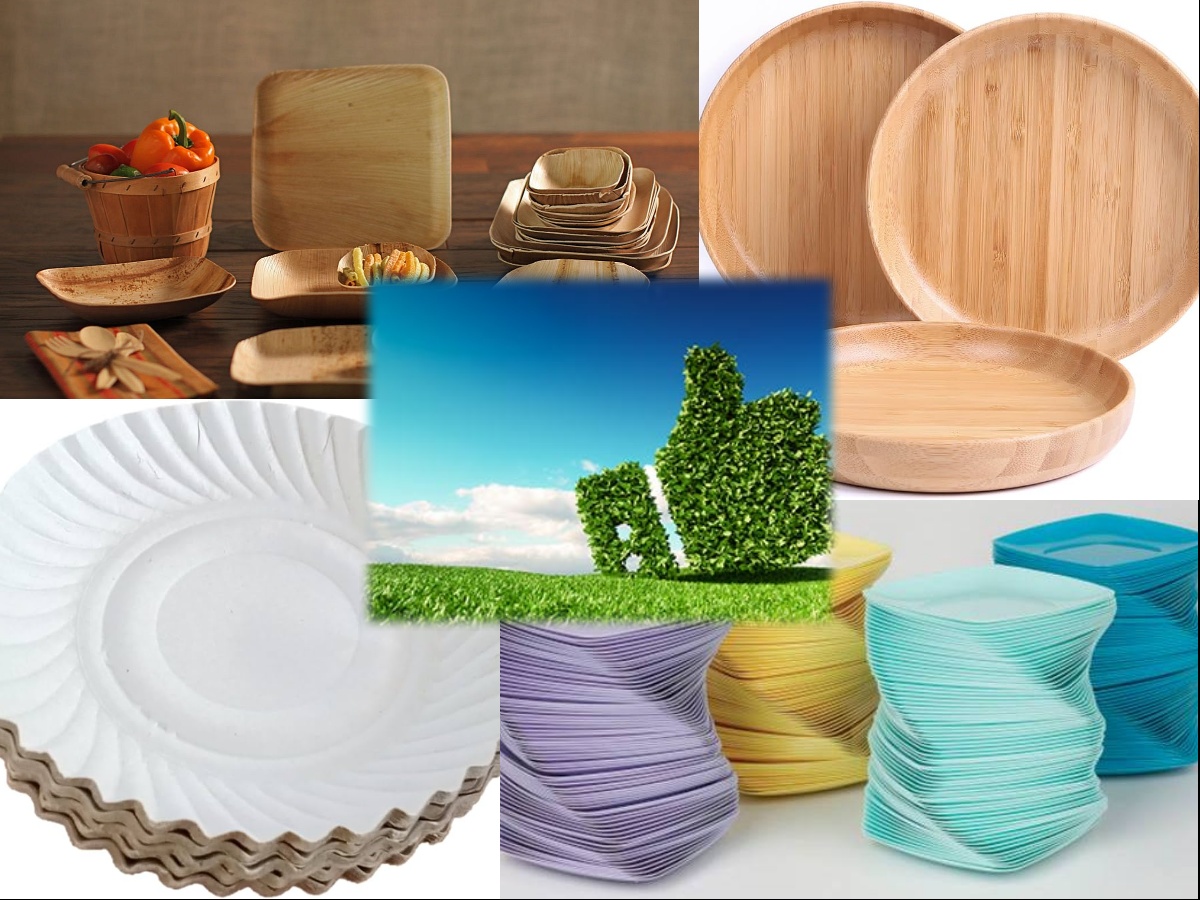Discover the beauty of eco-friendly dining with Palm Leaf Plates. Perfect for any occasion, these sustainable, biodegradable plates combine elegance with environmental responsibility.
Introduction
Embrace the elegance of sustainability with palm leaf plates, a chic, eco-friendly dining solution. Discover why these natural wonders are not just a trend but a lifestyle choice for those committed to making a positive environmental impact.
Table of Contents
What Are Palm Leaf Plates?
Palm leaf plates are an innovative and eco-friendly alternative to traditional dinnerware made from plastic or paper. These plates are crafted from the fallen leaves of the Areca palm tree, which are abundant in tropical regions. The process of making palm leaf plates is remarkably sustainable and involves collecting the shed leaves, which are then cleaned, steamed, and pressed into various shapes and sizes to create plates, bowls, and serving trays.
The production of palm leaf plates does not involve the use of any chemicals, making them a completely natural and biodegradable option. Once used, these plates can be composted, breaking down into nutrient-rich soil without leaving any toxic residue behind. This makes them an excellent choice for those looking to minimize their environmental impact.
One of the unique features of palm leaf plates is their natural, rustic appearance. Each plate has its own unique texture and pattern, reflecting the natural beauty of the leaf it was made from. This can add a charming and organic touch to any meal or event.
Palm leaf plates are also known for their durability and strength. They are sturdy enough to handle hot, wet, or oily foods without getting soggy or falling apart, which is a common issue with paper-based alternatives. This makes them suitable for a wide range of occasions, from casual picnics to elegant weddings.
Choosing palm leaf plates is not only a practical decision for serving food but also a statement in support of sustainable living and environmental responsibility. By opting for these biodegradable plates, individuals and businesses can reduce their carbon footprint and contribute to a healthier planet.

The Eco Elegance of Palm Plates
Aesthetic Appeal
Palm leaf plates offer a distinctive aesthetic appeal that sets them apart from conventional dinnerware. Their natural, earthy tones and unique textures provide a rustic yet sophisticated charm to any table setting. Each plate, with its own pattern and grain, tells a story of the natural world, bringing an organic and warm element to meals. This visual appeal is perfect for those aiming to create memorable dining experiences that also reflect a commitment to sustainable living.
Environmental Impact
The environmental benefits of choosing palm leaf plates over traditional plastic or disposable options are significant. Made from fallen leaves of the Areca palm that would otherwise decompose, their production has a minimal environmental footprint. The process is sustainable, requiring no trees to be cut down, no synthetic chemicals for manufacturing, and significantly less energy compared to the production of plastic or paper goods. By opting for palm leaf plates, individuals and events contribute to reducing waste and pollution, showcasing a commitment to environmental preservation.
Biodegradability and Compostability
One of the most compelling features of palm leaf plates is their complete biodegradability and compostability. After use, these plates can be composted, turning into nutrient-rich soil without leaving any harmful residues. This cycle of use and return to the earth underscores the principle of zero waste, making palm leaf plates an exemplary choice for those looking to minimize their ecological footprint. Their natural decomposition process enriches the soil, supporting further plant growth and contributing to a healthier ecosystem.

Benefits of Using Palm Plates
Durability and Strength
Palm plates are remarkably durable and strong, capable of withstanding a variety of food types without compromising their integrity. Unlike some eco-friendly alternatives that may bend or buckle under the weight of heavy or moist foods, palm plates maintain their shape and functionality. This strength makes them suitable for a wide range of culinary applications, from hot and cold dishes to oily and saucy meals, ensuring a reliable dining experience.
Versatility in Use
The versatility of palm plates is another significant benefit. They are appropriate for a wide array of events, from casual outdoor picnics to formal dining occasions. Their natural and elegant appearance lends itself well to any decor, adding a touch of rustic charm to the table setting. Furthermore, their biodegradability makes them a perfect choice for events where easy cleanup and minimal environmental impact are desired.
Safe and Chemical-Free
Palm plates are free from chemicals, making them a safer option for serving food. Unlike plastic or styrofoam options that can leach harmful substances into food, especially when heated, palm plates are made through a natural process that involves no synthetic materials or toxic additives. This makes them an excellent choice for those concerned about their health and the well-being of their guests.
Environmental Impact
Choosing palm plates significantly reduces the environmental impact associated with dining and events. Being fully biodegradable and compostable, they return to the earth without leaving harmful residues, unlike plastic, which can take hundreds of years to decompose. The production process of palm plates is also sustainable, utilizing fallen leaves that would otherwise go to waste, thereby minimizing deforestation and the carbon footprint associated with manufacturing traditional tableware.
Aesthetic Appeal
Palm plates possess a unique aesthetic appeal, with each plate featuring its own texture and pattern. This natural elegance can enhance the dining experience, making meals feel more special and connected to nature. Their rustic yet refined look is versatile enough to complement a variety of decor styles, from modern to traditional.
Economic Benefits
For businesses and event planners, the use of palm plates can also offer economic benefits. While the initial cost might be higher compared to traditional disposable plates, the positive environmental impact and unique aesthetic appeal can enhance the reputation of a business, attracting customers who value sustainability and quality. Additionally, the compostability of palm plates can reduce waste disposal costs over time.

How to Choose the Right Plates
1. Consider Your Needs
- Daily Use vs. Special Occasions: Decide whether you need plates for everyday use or special occasions. Plates for daily use should be durable and easy to clean, while those for special occasions can be more decorative and delicate.
- Family Size and Guests: The number of plates you need depends on your family size and whether you often host guests. It’s a good idea to have extra plates for visitors or parties.
2. Choose the Right Material
- Porcelain or China: Ideal for both everyday use and special occasions due to their durability and elegant appearance. They can be microwave and dishwasher safe, but check the manufacturer’s instructions.
- Stoneware: Known for its rustic look and durability. It’s heavier than porcelain and can add a warm, casual feel to your meals. Generally microwave and dishwasher safe.
- Earthenware: Offers an artisanal and earthy look but is less durable than other materials. Great for decorative pieces but may require more careful handling.
- Melamine: Extremely durable and break-resistant, making it perfect for outdoor dining, children, or high-traffic use. Not suitable for microwave use.
- Glass: Offers a versatile look that can range from casual to formal. Some glass plates are tempered for extra durability.
3. Think About Style and Color
- Match Your Decor: Consider plates that complement your dining room’s color scheme and style. Neutral colors like white or beige are versatile, while bold or patterned plates can add a pop of color.
- Shape and Design: Plates come in various shapes, including round, square, and oval. Choose a shape that matches your style and is practical for the types of meals you serve.
4. Size Matters
- Dinner Plates: Typically 10-12 inches in diameter, used for main courses.
- Salad Plates: Smaller than dinner plates, they’re used for salads or appetizers.
- Bread Plates: The smallest plate size, ideal for bread or small snacks.
Consider how much cabinet and table space you have, as some plate sizes and shapes may require more room.
5. Care and Maintenance
- Microwave and Dishwasher Safe: For convenience, look for plates that are microwave and dishwasher safe. Always check the manufacturer’s guidelines to ensure the longevity of your plates.
- Chip and Scratch Resistance: If durability is a concern, look for plates that are resistant to chipping and scratching.
6. Price and Budget
- Set a budget before shopping. Prices can vary widely based on material, brand, and design. While it’s tempting to go for cheaper options, investing in high-quality plates can be more cost-effective in the long run.
7. Environmental Considerations
- Sustainability: Consider the environmental impact of the materials. Some materials, like certain ceramics or recycled glass, are more eco-friendly.
- Ethical Production: Look for brands that prioritize ethical manufacturing processes and fair labor practices.

Incorporating Palm Plates into Your Events
1. Understand the Benefits
- Eco-Friendly: Palm plates decompose naturally, reducing waste and the use of non-biodegradable materials.
- Unique Appearance: Each plate has a unique texture and pattern, adding a natural and rustic aesthetic to your table setting.
- Durable: Despite being disposable, palm plates are sturdy and can handle hot, wet, or oily foods without getting soggy.
- Versatile: Suitable for a wide range of events, from casual gatherings to more formal occasions.

2. Consider the Event Theme
Palm plates fit perfectly with a variety of themes, especially outdoor events, garden parties, beach weddings, and eco-conscious gatherings. Their natural look can complement a rustic, tropical, or bohemian theme. Consider the overall aesthetic of your event to ensure the plates enhance the ambiance.
3. Pair with Other Sustainable Tableware
To maintain a consistent eco-friendly theme, pair palm plates with other sustainable tableware options, such as bamboo cutlery, glass jars for drinks, and cloth napkins. Using a combination of eco-friendly products not only reduces waste but also underscores your commitment to sustainability.
4. Decorate Thoughtfully
The natural color and texture of palm plates provide a beautiful backdrop for your food presentations. You can enhance their appearance with minimal table decorations, such as linen table runners, natural fiber placemats, or centerpieces featuring wildflowers or greenery. This approach keeps the focus on the eco-friendly nature of your event.
5. Educate Your Guests
Part of incorporating palm plates into your event can include educating your guests about the benefits of using sustainable materials. You could include a small note or sign explaining the origin of the palm plates and their environmental advantages. This can raise awareness and appreciation for your choice, making your event memorable and impactful.
6. Plan for Proper Disposal
Since palm plates are biodegradable and compostable, plan for their proper disposal. Arrange for compost bins at your event and clearly label them to ensure guests dispose of the plates correctly. This step is crucial to maximize the environmental benefits of using palm plates.
7. Source Responsibly
When purchasing palm plates, look for suppliers who source their products ethically and sustainably. Ensure that the plates are 100% natural with no added chemicals or binders. Supporting responsible manufacturers helps promote the sustainable production of eco-friendly tableware.
8. Sample Before Buying
Before placing a large order for an event, order a sample pack of palm plates to evaluate their quality and appearance. This will help you confirm that they meet your expectations and are suitable for the type of food you plan to serve.
Care and Maintenance
1. Clothing and Textiles
- Washing Instructions: Follow the garment’s label for washing temperatures and recommended cycles. Separating lights from darks and using a gentle detergent can preserve colors and fabric integrity.
- Storage: Store clothing in a cool, dry place. Use cedar balls or lavender sachets to deter moths. Fold heavy sweaters instead of hanging them to avoid stretching.
2. Kitchenware
- Non-Stick Cookware: Use wooden or silicone utensils to avoid scratching the surface. Hand wash with a soft sponge and avoid using abrasive cleaners.
- Cast Iron: After use, clean with hot water and a stiff brush. Avoid soap, and always dry thoroughly. Season the pan with oil to maintain its non-stick surface.
- Silverware: Polish silverware regularly to prevent tarnishing. Store in a dry place or use anti-tarnish strips to slow down the tarnishing process.
3. Electronics
- General Care: Keep devices clean and dust-free with a soft, dry cloth. Avoid exposure to liquids and extreme temperatures.
- Battery Maintenance: For laptops and smartphones, maintain battery health by not leaving them plugged in all the time. Perform regular full charge cycles.
- Cable Management: Keep cables organized and avoid bending them at sharp angles to prevent damage.
4. Furniture
- Wooden Furniture: Dust regularly and use coasters to prevent rings. Treat with the appropriate oil or polish to keep the wood hydrated.
- Upholstered Furniture: Vacuum regularly and clean spills immediately with the recommended cleaning products to avoid stains.
- Metal Furniture: Wipe with a damp cloth and avoid harsh chemicals. For outdoor pieces, use protective covers to prevent rust.
5. Footwear
- Leather Shoes: Condition regularly to prevent drying and cracking. Use shoe trees to maintain shape and absorb moisture.
- Sneakers: Clean with a soft brush and mild detergent. Allow to air dry.
- Storage: Keep shoes in a well-ventilated area or use silica gel packs to absorb excess moisture.
6. Garden Tools
- Cleaning: Clean soil and debris off tools after each use. Dry thoroughly to prevent rust.
- Sharpening: Sharpen blades regularly to maintain effectiveness.
- Storage: Store in a dry, organized space. Hanging tools can prevent damage to the blades and handles.
7. Vehicles
- Regular Maintenance: Follow the manufacturer’s schedule for oil changes, tire rotations, and other maintenance tasks.
- Cleaning: Wash the exterior regularly to prevent rust and protect the paint. Clean the interior to avoid wear and tear on materials.
- Tire Care: Check tire pressure monthly and adjust as needed. Inspect tires for wear and replace them when necessary.
8. Jewelry
- Cleaning: Use a soft brush and appropriate cleaning solutions based on the type of jewelry (e.g., gold, silver, gemstones).
- Storage: Store pieces separately in a lined jewelry box to prevent scratching and tangling.
- Professional Care: Have valuable pieces inspected and cleaned by professionals annually.

Challenges and Considerations
1. Environmental Sustainability
- Challenges: Balancing economic growth with environmental preservation, combating climate change, and managing natural resource depletion.
- Considerations: Implementing sustainable practices, investing in renewable energy, and promoting conservation efforts. Policymakers and businesses must consider long-term ecological impacts alongside short-term gains.
2. Digital Privacy and Security
- Challenges: Protecting personal and organizational data against cyber threats, ensuring privacy in an increasingly digital world, and managing the ethical use of technology.
- Considerations: Implementing robust cybersecurity measures, educating users about digital hygiene, and developing policies that respect user privacy while ensuring security.
3. Healthcare Access and Quality
- Challenges: Providing equitable access to healthcare services, addressing disparities in healthcare quality, and managing the rising costs of healthcare.
- Considerations: Healthcare policies must aim to make healthcare affordable and accessible to all, improve the quality of care, and invest in preventive measures and public health initiatives.
4. Education Equity
- Challenges: Closing the achievement gap between different socio-economic groups, providing equal access to quality education, and adapting to changing educational needs.
- Considerations: Implementing inclusive education policies, investing in teacher training, and leveraging technology to provide personalized learning experiences can help address these challenges.
5. Urbanization and Infrastructure
- Challenges: Managing the rapid growth of urban areas, ensuring sustainable infrastructure development, and addressing housing affordability.
- Considerations: Urban planning should focus on sustainable development, integrating green spaces, and creating efficient public transportation systems to reduce congestion and improve quality of life.
6. Globalization and Cultural Preservation
- Challenges: Balancing the benefits of globalization with the need to preserve cultural identities and traditions.
- Considerations: Promoting cultural exchange and understanding, supporting local industries and crafts, and protecting intangible cultural heritage against the homogenizing effects of globalization.
7. Workforce Automation and the Future of Work
- Challenges: Managing the displacement of jobs due to automation, retraining workers, and addressing the skills gap in emerging industries.
- Considerations: Developing policies that support workforce retraining and education, fostering innovation in job creation, and ensuring a fair transition for affected workers.
8. Climate Change Adaptation and Mitigation
- Challenges: Reducing greenhouse gas emissions, adapting to the impacts of climate change, and financing climate action.
- Considerations: Investing in renewable energy, promoting energy efficiency, and developing adaptive infrastructure to withstand climate-related disasters are crucial steps.
9. Social Inequality and Injustice
- Challenges: Addressing systemic inequalities, combating discrimination, and ensuring equal opportunities for all individuals.
- Considerations: Implementing social policies that promote equity, protecting human rights, and fostering community engagement and dialogue can help tackle these issues.
10. Technological Advancements and Ethics
- Challenges: Navigating the ethical implications of emerging technologies such as artificial intelligence (AI), biotechnology, and surveillance technologies.
- Considerations: Developing ethical guidelines for the use of technology, ensuring transparency in AI decision-making processes, and considering the societal impacts of technological innovations.
Testimonials and Success Stories
1. Educational Program Success Story
“After enrolling in the new digital literacy program, I’ve seen remarkable progress in my skills and confidence with technology. Before, I struggled with basic tasks on a computer. Now, I’m building my own website and have even started teaching digital skills to others in my community. This program has not only equipped me with valuable skills but has also opened up new career opportunities.”
2. Healthcare Service Testimonial
“Finding quality healthcare that I could afford was a constant struggle. However, since I discovered this community health clinic, my perspective on healthcare has completely changed. The staff’s dedication and the comprehensive care I received have dramatically improved my health and well-being. It’s a relief to know that there’s a place I can turn to for help without fearing the cost.”
3. Technology Product Testimonial
“The efficiency and reliability of this project management software have transformed how our team operates. Tasks that used to slip through the cracks are now systematically managed and completed on time. Our productivity has increased significantly, and the team feels more cohesive and aligned. It’s been a game-changer for our projects and client satisfaction.”
4. Non-Profit Organization Success Story
“Our non-profit has always aimed to make a tangible difference in the community, but it wasn’t until we launched our after-school program for underprivileged children that we saw the true impact of our work. Attendance and academic performance have improved significantly among participants, and parents report a noticeable increase in their children’s confidence and social skills. This success has motivated us to expand our programs and reach even more children.”
5. Small Business Growth Testimonial
“Starting a small business is challenging, especially in a competitive market. However, with the right guidance and resources from the local business development center, we’ve not only survived but thrived. In two years, we’ve doubled our revenue, expanded our product line, and hired more staff. The personalized support and advice we received were instrumental in our growth.”
6. Environmental Initiative Success Story
“Our city’s commitment to reducing carbon emissions seemed ambitious at first. Yet, through community engagement and strategic investments in green infrastructure, we’ve seen a significant decrease in pollution levels. Public transport is more efficient, green spaces have flourished, and residents are actively participating in sustainability efforts. It’s a testament to what can be achieved when a community comes together for a common goal.”
7. Personal Achievement Story
“Completing a marathon was always on my bucket list, but it felt out of reach until I committed to a structured training program. The journey was tough, filled with early mornings and sore muscles, but crossing that finish line was one of the most exhilarating experiences of my life. It taught me that with perseverance and the right support, I could achieve goals that once seemed impossible.”

Where to Find Palm Leaf Plates
1. Online Retailers
Online platforms offer a vast selection of palm leaf plates in various shapes, sizes, and quantities. Websites like Amazon, Etsy, and eBay are excellent starting points, providing options from numerous sellers. You can compare prices, read reviews, and check for eco-certifications to ensure you’re getting high-quality and sustainably sourced products.
2. Specialty Eco-Friendly Stores
Many online and brick-and-mortar stores specialize in eco-friendly and sustainable products. These stores often stock palm leaf plates alongside other biodegradable and compostable tableware. Shopping from these stores can also expose you to other eco-friendly products that might interest you.
3. Restaurant Supply Stores
If you’re buying in bulk, especially for events or commercial use, restaurant supply stores can be a great resource. These stores typically offer palm leaf plates in large quantities at wholesale prices. Some popular options include WebstaurantStore and RestaurantSupply.com.
4. Party Supply Stores
For those planning a party or special event, local party supply stores often carry a selection of palm leaf plates. While the range might be more limited compared to online retailers or specialty stores, you can find basic options suitable for various events.
5. Farmers Markets and Eco-Fairs
Local farmers markets and eco-fairs sometimes feature stalls from local artisans and eco-friendly product vendors, including those selling palm leaf plates. This is a great way to support local businesses and find unique, high-quality products.
6. Wholesale Clubs
Members of wholesale clubs like Costco or Sam’s Club might find bulk packages of palm leaf plates available at competitive prices. Availability may vary by location and season, so it’s worth checking their online or in-store selection.
Tips for Buying Palm Leaf Plates:
- Check Reviews: Before purchasing, especially online, read customer reviews to gauge the quality and durability of the plates.
- Compare Prices: Prices can vary widely based on the seller, quantity, and quality. Compare options across different platforms to find the best deal.
- Look for Certifications: Certifications can indicate that the plates are sustainably sourced and produced in an environmentally friendly manner. Look for relevant eco-certifications or information about the sourcing and manufacturing processes.
- Consider the Event Size: Estimate how many plates you’ll need for your event and consider buying in bulk to save money. Some retailers offer discounts for larger quantities.

Making the Switch
1. Start with Research
- Understand the Benefits: Learn about the positive impacts of the change, such as reducing waste, minimizing carbon footprint, or improving personal health.
- Identify Alternatives: Research sustainable alternatives for products or practices you currently use. For instance, if you’re switching to palm leaf plates, explore the range of products available and their environmental benefits.
2. Evaluate Your Needs
- Assess Current Usage: Look at your current habits or products to identify where you can make changes. If you’re focusing on reducing plastic waste, note how often you use disposable plastics.
- Prioritize Changes: Decide which changes are most feasible and impactful. Starting with easier switches can help build momentum.
3. Set Realistic Goals
- Small Steps: Begin with achievable goals. For example, aim to use sustainable tableware at your next event instead of making an immediate full switch for all dining occasions.
- Track Progress: Keeping a record of your transition can motivate you and highlight the difference you’re making.
4. Educate Yourself and Others
- Learn About Sustainability: Understanding the broader context of why sustainable choices matter can reinforce your commitment to making the switch.
- Spread Awareness: Share your knowledge and experiences with friends, family, or through social media. Your journey can inspire others to consider making similar changes.
5. Be Prepared for Challenges
- Cost Considerations: Eco-friendly products may sometimes be more expensive. However, their long-term benefits, such as reduced waste and environmental impact, can outweigh initial costs.
- Availability: Some sustainable alternatives might not be as readily available. Online shopping can offer a wider selection than local stores.
6. Seek Community Support
- Join Groups: Online communities and local groups can provide support, advice, and encouragement as you make the switch.
- Learn from Others: Engage with people who have already made similar changes. Their insights can offer valuable tips and motivation.
7. Make it a Lifestyle
- Integrate Fully: Gradually incorporate sustainable practices into your daily routine until they become second nature.
- Continuously Improve: Sustainability is a journey. Stay informed about new products, technologies, and practices that can further reduce your environmental impact.
8. Reflect on the Impact
- Personal Benefits: Notice any positive changes in your life, such as improved health, savings, or a sense of accomplishment.
- Environmental Impact: Consider the broader effects of your choices on the planet and future generations.

Conclusion
Embracing sustainable practices, like using palm leaf plates, is a key step towards reducing environmental impact. The transition involves research, setting achievable goals, and gradually incorporating eco-friendly habits. Despite challenges like cost and availability, the benefits to the planet and future generations are substantial. Education, community support, and sharing experiences are vital in this journey. Every small, sustainable choice contributes to a larger positive impact, advocating for a healthier, more sustainable world.










